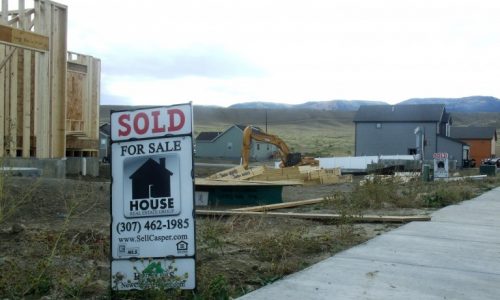When Landis Benson, president of the Wyoming Association of Realtors was asked if he thought there a Wyoming real estate bubble — when market prices rise rapidly due to high demand (as they did in the state during the energy boom in the early part of the decade) until they reach unsustainable levels, prompting a steep decline — Benson said that while prices have declined “a bit” in the areas hardest hit by the energy bust, they have otherwise remained fairly steady.
But all that could change if an anticipated surge in foreclosures hits harder than expected. In general, many analysts say there is anywhere from a six- to 24-month gap between when an economic downturn occurs and when foreclosures start to go up as workers are unable to find new jobs — or settle for lesser-paying positions — and their savings and unemployment benefits run out. A wave of energy layoffs, most notably in the coalfields of the Powder River Basin, hit the state this spring — around six months ago.
The concern is that a wave of foreclosures will force the banks to reduce the prices on the homes they take over to the point where it pulls the entire market down, leaving many homeowners with houses worth far less than what they paid for them. The 2007 financial crisis was caused in part by the bursting of real estate bubbles inflated by a proliferation of sub-prime mortgages given out to more risky borrowers.
“We are still going to have some downward pressure in areas, because we are expecting a wave of foreclosures in the hardest hit areas and that will certainly have an impact on local values,” Benson said. “Again, this is a regional issue and the more energy-dependent communities will probably experience some level of foreclosure, which always impacts prices.”
Earlier this year, a report by Arch Mortgage Insurance, a California-based firm specializing in mortgage credit default protection, said the national housing market was strong nationally, but was slumping in big energy-producing states like Wyoming where “total employment continues to weaken, even as home prices continue to rise.”
“The energy patch will experience slower than normal economic and home price growth,” the report said. “And a few areas may see outright home price declines.”
“The jobs are leaving, and if an area gets depopulated, they can’t take the houses with them and that’s dangerous for the housing market,” said Ralph DeFranco, director of risk analytics at Arch. DeFranco said Wyoming is facing some of the biggest risks of falling home prices.
However, DeFranco said some analysts feel that since the state actually started out with a housing shortage, the energy downturn could actually lead to a more-balanced market.
Find more on the Wyoming Real Estate residential market, in the October edition of the Wyoming Business Report.

